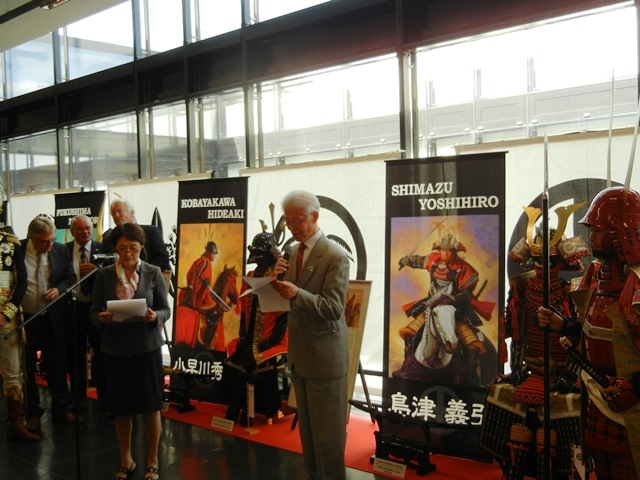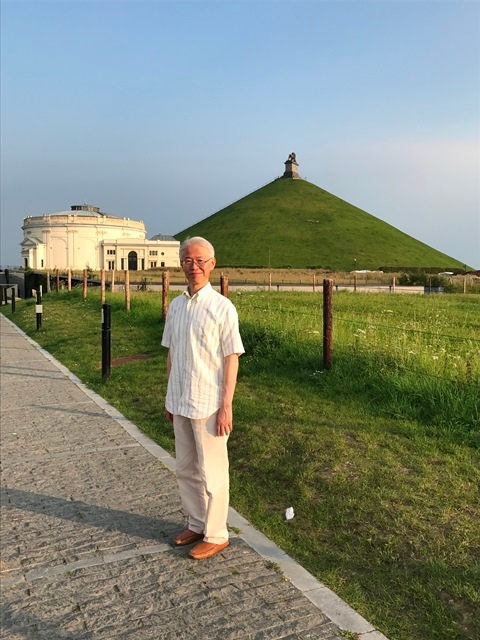Waterloo and Sekigahara (No. 4)
 On August 31, a delegation from Gifu Prefecture, including Governor Hajime Furuta and Sekigahara Mayor Yasuo Nishiwaki, visited the battlefield of Waterloo and participated in a conference with Walloon-Brabant Governor Gilles Mahieu, as well as representatives from the cities of Braine-l'Alleud, Waterloo, Genappe and Lasne. Together, they signed a Sister Battlefield Agreement between Waterloo and Sekigahara. On August 31, a delegation from Gifu Prefecture, including Governor Hajime Furuta and Sekigahara Mayor Yasuo Nishiwaki, visited the battlefield of Waterloo and participated in a conference with Walloon-Brabant Governor Gilles Mahieu, as well as representatives from the cities of Braine-l'Alleud, Waterloo, Genappe and Lasne. Together, they signed a Sister Battlefield Agreement between Waterloo and Sekigahara.
I believe that starting cooperation and exchange between the historically famous battlefields of Waterloo and Sekigahara on the occasion of the 151st anniversary of the establishment of friendship relations between Japan and Belgium is of significance. It is expected that cooperation and exchange between the people of Gifu Prefecture and the town of Sekigahara with the people of Walloon Brabant and its related cities, will progress under the Sister Battlefield Agreement.
Waterloo is located approximately 18km south of Brussels, and 202 years ago, on 18 June 1815, it was the stage of a large battle which would later decide the course of European history. It was there that the French army led by Emperor Napoleon clashed with the allied British and Dutch armies led by Wellesley, Duke of Wellington, and the Prussian army led by General von Blücher. In total, almost 200.000 troops collided with each other, and for about half a day one of Europe’s most famous battles unfolded.
Countless comments and analyses have been made about this battle, and it even appears in Victor Hugo’s famous novel “Les Miserables”. In my opinion, there are three points which decided the outcome of the battle. First, there was the heavy rain since the previous night, June 17, all through the early morning of June 18. Because of this, the start of the mobilization of France’s main force was delayed. It is said that the ground in particular was so muddy that it took an unexpectedly long time to move the artillery troops. For this reason, contrary to Napoleon’s first assumption, it became impossible to overthrow the British-Dutch allied forces before the Prussian army advanced.
Secondly, at the Hougoumont farm, which was at the center of the first half of the battle, defending British troops fought very well and stopped the advance of the French army. By the way, at this time, the main force of the British army had not yet returned from the War of 1812 on the North American continent. Whereas the British troops that fought in Waterloo were unexperienced, the French army was centered on the veteran guards of Napoleon who had fought along him for many years and it is said that the morale of these troops was high.
 Thirdly, the French detached force that had been dispatched to deal with the Prussian army were unable to locate it. Because of this, at the end of the battle, while the French and the allied British-Dutch army were in a fierce battle, Prussian troops rushed to the rescue which gave the decisive blow, causing the French army to collapse. Thirdly, the French detached force that had been dispatched to deal with the Prussian army were unable to locate it. Because of this, at the end of the battle, while the French and the allied British-Dutch army were in a fierce battle, Prussian troops rushed to the rescue which gave the decisive blow, causing the French army to collapse.
It is easy to understand that the people of the Walloon Brabant province and the related cities have made great efforts to preserve the historic site of the battlefield of Waterloo and to pass on the facts on the battle to future generations. In 2015 especially, which marked the 200th anniversary of the Battle of Waterloo, facilities were improved. It marked the opening of the underground visitor center with video projections and exhibitions making use of state-of-the-art technologies. It allows many people today to experience the battle as if they were participating themselves.
On the other hand, in Sekigahara Town in Gifu Prefecture, located almost in the center of Japan, a big battle that would decide the history of Japan thereafter took place 417 years ago on October 21, 1600 (15th day of the 9th month of the 5th year Keichō). A total of more than 150.000 troops consisting of the eastern army, led by Ieyasu Tokugawa, and the western army, centered around Mitsunari Ishida, clashed for half a day in what became the most famous battle in Japanese history.
Many commentaries and analyses about the Battle of Sekigahara have been published in Japan, just as many novels, movies, and TV dramas have been created, so I would like to refrain from touching upon the details here. Just now, a movie featuring popular actors and actresses, based on the novel "Sekigahara" by Ryotaro Shiba, has been released in Japan, attracting many viewers.
In Japan as well, the local Gifu Prefecture and the town of Sekigahara are continuing their efforts to preserve the historic battlefield site and convey the facts of the battle to future generations.
In this way, although the country and the time are different, it is extremely natural and important for two regions which have had large troops engaged in intense battles, to cooperate and deepen exchanges. It is meaningful for both parties to share experiences and technologies with each other regarding the preservation and management of historical sites and the inheritance of historical facts. Also, good cooperation is expected in terms of how to use historically famous battlefields for economic development in the area, including tourism.
Finally, as a person engaged in diplomacy, I would like to add something. When talking about ancient battlefields, it is absolutely necessary for us to turn our thoughts to the victims of the battle.
In the battle of Waterloo, the French army counted around 40.000 casualties, prisoners or missing. The allied forces of the United Kingdom and the Netherlands suffered losses of about 27.000, and the Prussian army around 7.000. In the battle of Sekigahara, it is said that only counting the war dead, about 4.000 to 10.000 people of the eastern army and about 8.000 people of the western army had fallen. Looking at it in this way, it can be said that large battles brought about large human sacrifices.
Having in mind such a big sacrifice, an era of efforts to maintain the balance of power between major countries by diplomacy and to prevent the occurrence of war lasted in Europe after the Battle of Waterloo. For one hundred years until the outbreak of World War, it can be said that these efforts did produce certain results. Although there are differences depending on the country or region, it is well known that during this period in Europe political development toward the formation of nation states and the establishment of a political system where people's rights are better protected, economic development such as the industrial revolution and cultural development in several fields were realized.
In Japan too, after the battle of Sekigahara, the Tokugawa family, who won the battle, established the shogunate system marking the start of a basically peaceful period of about 260 years. It can be said that this period is an important era during which the foundation for the great development of Japan since the 19th century was laid in a wide range of fields such as economy, society and culture.
And so, looking back upon the battle of Waterloo and the battle of Sekigahara, I am certain that preserving historic sites of past battles and conveying the facts on the battles promotes our respect for peace and teaches us the fruits brought by peace.
|